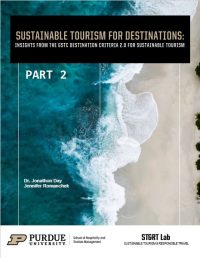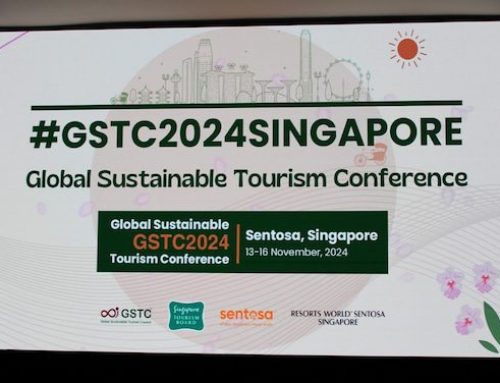Introduction

The Global Sustainable Tourism Council (GSTC), the leading organization on sustainable tourism accreditation, recently released their Destination Criteria 2.0. It provides a common framework for examining destination-level sustainable tourism certification. The GSTC criteria are organized in four sections: sustainable management, socio-economic sustainability, cultural sustainability, and environmental sustainability. With these 4 sections there are 38 criteria and 174 indicators that destinations may use to assess their progress on achieving the criteria.
New Perspective:
This report (Part 2 of 4) will focus on the:
- Planning
- Policy Framework
Tourist destinations are complex systems. In this report, we use the term “destination” without designating a specific actor. It is important to note that we are not implying that either the local Destination Stewardship Organization (A1) or Destination Management Organization (DMO) is the sole responsible party.
Planning for Sustainable Tourism in Destinations
The benefits of sustainable tourism in a destination are achieved and based on the careful analysis of the destination’s resources and their key stakeholders.
Destination Management Strategy and Action Plan [2]:
The GSTC criteria requires the development of a Destination Management Strategy to be designed. It’s purpose is to support the long-term sustainability of the destination. The long-term strategy should:
- Be suited to the scale of the destination
- Developed with stakeholders and publicly available
- Based on sustainability principles
- Aligned with other sustainability plans in the community
GSTC criteria encourage destinations to assess their environmental, cultural, social assets, as a foundation for the planning process. Planning should be collaborative amongst the stakeholders.
The GSTC criteria also highlights a number of components of sustainable destination management that require dedicated planning. These plans may be integrated into the destination management strategy or stand-alone plans. The GSTC criteria suggests that each destination should have plans in place to:
- Protect the local culture, heritage and traditions
- Protect the local environment
- Mitigate and adapt to climate change [3,4]
- Encourage Tourism Businesses to adopt Sustainable Tourism Practices
- Manage Visitors
- Have a system in place for Risk and Crisis Management
- Implement Safety and Security Plans [5]
- Manage Workforce Development
Policy Framework for Sustainable Tourism in Destinations
Destinations require a policy framework to support sustainable tourism practices. Destinations must implement policies to facilitate sustainable development, protect the environment, socio-cultural impacts and economic factors. Policies must include references to international, national, and local laws.
Building and Development Policies [6]:
Destinations that would like to become sustainable should have policies that ensure:
- Environmental, social, and economic impact assessment before any development is approved
- Sustainable natural resources practices
- Sustainable design and construction standards for new developments
- Community established aesthetic standards
- Building and development policies to protect natural and cultural resources
Environmental Policies:
They should have laws that encourage tourism related businesses to protect the environment by:
- Practicing energy conservation
- Reducing fossil fuel use
- Increasing use of renewables
- Encouraging wastewater reduction
- Encouraging water conservation
- Requiring wastewater management including siting, maintenance and monitoring of discharge
- Minimizing light and noise pollution
Additionally, destinations should also have laws or regulations that govern interaction with wildlife and align with international laws and standards [7].
Cultural and Heritage Policies [8]:
Sustainable tourism destinations will have policies in place to protect cultural assets including built heritage and cultural landscapes. The destination will also have policies governing the sale and display of any archaeological artefacts (9).
Safety and Security Policies [10]:
Sustainable destination communities should have laws, policies and regulations that ensure the well-being of visitors in the destination. These policies should address not only crime but safety and hygiene standards.
Eliminating Exploitation and Discrimination [11]:
Sustainable destination communities should have laws, policies and regulations that ensure:
- Equal employment opportunities for all, including women, youth, minorities and other vulnerable populations
- Fair wages for all, including women, youth, minorities and other vulnerable populations
- Occupational health and safety rules for tourism businesses
- Elimination of commercial, sexual or other types of exploitation of anyone, particularly women, youth, minorities and other vulnerable populations
Accessibility and Inclusion [12]:
Sustainable destination communities should have laws, policies and regulations that ensure:
- Access to tourist sites and facilities are available to individuals with disabilities or other access requirements
- Public access by local community members
Property and User Rights Policies [13]:
Sustainable destination communities should have laws, policies and regulations that ensure:
- Established property rights are acknowledged
- Property acquisition rights that consider indigenous rights
- Intellectual property rights of individuals and communities [14]
- Access to natural and cultural sites for the local community
[2] A2: Destination Management Strategy
[3] A10: Climate Change Adaptation
[4] D10: GHG emissions and Climate Change Mitigation
[5] A11: Risk and Crisis Management
[6] A9: Planning Regulation and Development Control
[7] D3: Wildlife Interaction
[8] C1: Protection of Cultural Assets
[9] C2: Cultural Artifacts
[10] B7: Safety and Security
[11] B5: Preventing Exploitation and Discrimination
[12] B8: Access for All
[13] B6: Property and User Rights C4: Traditional Access
[14] C5: Intellectual Property
The is part 2 of a series of 4 parts:
- Insights from the GSTC Destination Criteria 2.0 – Part 1
- Insights from the GSTC Destination Criteria 2.0 – Part 2
- Insights from the GSTC Destination Criteria 2.0 – Part 3
- Insights from the GSTC Destination Criteria 2.0 – Part 4
Download: pdf file available here
Source: Dr. Jonathon Day & Jennifer Romanchek, School of Hospitality and Tourism Management
Sustainable Tourism and Responsible Travel Lab ( STaRTlab)
Purdue University | College of Health and Human Science
Web adaptation: Valentina Gambino




